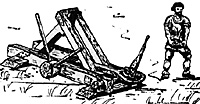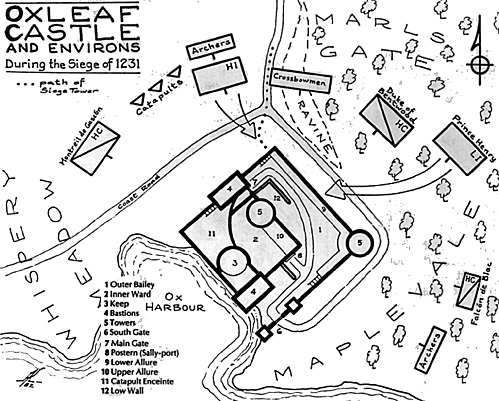SIEGE PREPARATIONS
 Although Marnian siege preparations at Gaudy Castle
were for naught, the forces now assembled were poised for
any eventuality.
Although Marnian siege preparations at Gaudy Castle
were for naught, the forces now assembled were poised for
any eventuality.
Onager type catapult similar to those built at the seige of Oxleaf.
The Duke resolved to take advantage of his army's readiness for a siege, and in the second week of June he began his move against the Tatars in Oxleaf Castle. This move was contrary to advice from the Earl of Windfor (Falcon deBlac), who was fearful of the enemy's combined strength and wanted to wait for reinforcements. The Duke, however, decided to begin the march and initiate the siege as soon as possible. Additional troops would join them later.
The Duke knew that the siege would be a long and laborious task requiring weeks of preparation. He decided to bring the siege tower constructed at Gaudy. The road connecting Oxleaf Castle with Gaudy would facilitate this operation provided that it was secure. Montreil cleGascon's crossbowmen were dispatched to scout and secure the route. DeGascon and his knights followed two days later.
After the surviving Teutonic Knights returned to their castle at Gaudy and the Marnon Army departed, 2 ungarrisoned castles remained: the Templar's Hempen Rook and the Hospitallers' Kilgarren. Marnon was now able to supply an army of 2500, with reinforcement rates of 20 cavalry and 60 infantry per week plus an additional 40 cavalry every 4th week, compared with the ideal maximum military resource of 4000. Perhaps deBlac's fears were unfounded after all.
Toghrul Khan expected a siege and prepared to hold out until his reinforcements arrived by sea. It was imperative for Ox Harbour to be protected, for that is where his ships were instructed to return. As an extra precaution, he dispatched horse archers to reconnoiter Island Harbour and to frustrate Marnian supply operations after the siege began. Sir John de Marl was now a prisoner in his own castle and was doubtlessly used by the Khan to prepare to resist the siege.
THE PROTRACTED SIEGE
On June 21st, the besieging army arrived and encamped surrounding Oxleaf Castle. Their reinforcements were on the way to Flintcastle where Sir Henry, the Prince of Dunes, prepared and organized them into self-sufficient units before joining the siege, as required later.
The Duke of Bentwood's now familiar offer to the defenders to surrender was ignored. His next offer was safe conduct if deMarl was released and the castle surrendered.
It triggered a counter--offer from Toghrul Khan--release of deMarl in exchange for sappers and engineers skilled in the building of the catapults. Bentwood refused. The Duke's next offer -- safe conduct if a hostage of deMarl's rank remained -- drove the Khan to his limit of patience: the Frankish messenger's severed head rolled off the parapets in reply. There was little doubt now that the siege would begin in earnest ...
Bentwood also possessed an expert on the castle's defenses, Lord Oxleaf, co-owner (with deMarl) of Oxleaf Castle. Relying on Oxleaf's advice, Brentford planned an escalade using numerous ladders, and the siege tower would assault the weakest point in the wall surrounding the outer bailey. This weakness was attributed to the end of the allure, preventing large concentrations of wall defenders and enemy missile troops in only one bastion being utilized against a siege tower assault here.
The other attraction to this plan was its potential for eliminating the need for an extended siege. Within a fortnight all was ready and as the last ladders were hammered together, the ponderous siege tower was rolled into position at the crossroads just outside the North corner of the wall.
To everyone's surprise (and interruption of the Duke's plan), Prince Henry appeared in the woods of Marls Gate. A large levy of light infantry with their own ladders and climbing ropes accompanied him. (This unexpected development was the result of "Disobedience & Own Initiative" rules, inspired by those given for leaders in Dave Millward's "God's Acre" and expanded to a broader scope to include royalty and members of the ruling class acting on their own initiative whenever a die-roll of 6 results upon receipt of new orders involving them.)
Delayed
Although delayed for another day (new arrivals need a day to be battle-ready), the escalade plan went into effect on the morning of July the 2nd. Archers and crossbowmen in the ravine lent massive missile support and the siege tower slowly advanced into the position recommended by Lord Oxleaf. The heavy pike infantry, led by the lord himself, were first to reach the wall. They were almost immediately followed by Prince Henry's lights scaling the Northeast wall. The light infantry, due to their lack of armor, suffered severe losses inflicted from Tatar archers on the lower allure, and also those in both towers as well as the upper allure. They broke into a rout within minutes of scaling the wall and fled back into the forest. Sir Henry was unable to rally them. (See diagram of Oxleaf Castle.)
The pikemen on the siege tower, however, reached the lower allure and began their descent into the outer bailey. Their supporting archers on the wall behind them provided missile support. The crossbowmen and Montreil cleGascon's dismounted knights followed. Their aim was to work their way to the South Gate and admit the rest of the army into the castle.
Before this feat could be accomplished, however, the defenders set the siege tower on fire with naptha and fire arrows. At the same time they tried to resist the archers coming over the wall. They defended successfully themselves and routed the archers. The pikemen, fighting with swords and with their missile support gone, were in great peril. Lord Oxleaf and 60 of his men were lost before they could retreat.
The assault failed, though most of the Tatars on the lower allure were also lost. DeGascon rallied his archers but Marnon's losses were sevre. The militia class levy and the archers, suffered most due to their inability to maintain morale. Although morale was not a problem for the veteran pikemen, they could not proceed without missile support. Nevertheless, the besiegers' concentration of force was inadequate for a frontal assault.
Faced with his first major failure, the Duke of Bentwood now concluded that this would be a long protracted siege and began preparations accordingly. Work began on constructing a ram and a roofed cat in addition to the two catapults of the onager type (see illustration) to supplement the crossbow catapult mentioned previously. Replacements once again rallied to Prince Henry's cause at Flint Castle in anticipation of the next assault, now planned for mid-August. By that time, after 8 weeks under siege, attrition within castle walls would dissipate the defenders in addition to their losses already sustained in battle. Without replacements, their condition would be softer.
As time wore on, it became apparent that cavalry reinforcements from the Castle of Dunes were not arriving as expected. This snag was due to Toghrul's horse archers who intercepted them at various places in Whispery Meadow and the Golden Dunes, killing all in stealthy ambush.
The besiegers were not yet aware of these units operating behind their lines and the Duke of Bentwood suspected treachery. The tribal archers continued their work unhindered, controlling everything that moved through these regions. Frankish reinforcements and supply columns, under orders to proceed to their destination by the shortest route, repeatedly encountered these Tatar units. No survivors disclosed their whereabouts. Thus the Castle of Dunes was virtually cut off without even suspecting such a possibility!
Next Turn of Events
The next turn of events was beyond anyone's control. Moderate weather throughout the campaign had lulled everyone into complacency. Just as the main assault began the rains erupted non-stop for five days, turning the ground into untenable morass and destroying both bridges across the Amnon, isolating NW Marnon, including the Castle of Dunes. Movement was difficult throughout the countryside and fighting was totally out of the question. The weather was very unusual for mid-summer in Marnon, as may be seen in the Weather Table shown in the appendix. Faced, again, with, an impasse, the campaign displayed signs of stabilizing. Flood damage had to be repaired, and ships and harbors prepared for the coming winter. just 2 months of good weather remained before the harsh Marnian winter set in. There was little hope of establishing a decisively superior force to drive out the invaders before the snow came.
The Duke of Bentwood would not risk another futile attempt in the face of his recent failure without more advantageous odds. The siege continued, but only to contain the enemy and keep their activities restricted. Tatar skirmish units were known to be operating outside the Oxleaf area in September, but their exact whereabouts were unknown. Several months might pass before another major action could begin. Toghrul Khan's army was still quite powerful, with 25% shock troops and over a third of the total elite remaining. Marnon had fully twice their number, but only one-sixth were elite and over 50% were militia. A comparison of strengthsA comparison of strengths clearly illustrates Marnon's superiority, but the need to deploy over a wide area and keep the castles manned, reduced any advantage against a concentrated enemy now firmly established in the South.
NOTE ON REINFORCEMENT
It may be noteworthy to review the mechanics of reinforcement and supply system used during the Marnon Campaign. Based on the feudal system of military service, castles served this function; each limited in its capacity, as follows (each figure = 20 troops):
| Bentwood Castle | 1 infantry and 1 cavalry figure per week. |
| Flint Castle | 1 infantry figure per week and 1 cavalry figure per month. |
| Fernharn Castle | 1 infantry figure per week. |
| Castle of Dunes | 1 cavalry figure per month. |
Oxleaf Castle provided an infantry figure per week before the Tatar occupation, but the 3 religious military order castles (Kilgarren, Gaudy and Hempen Rook) never owed military service to the Dutchy of Marnon. They were castles of refuge for the Templars, Hospitallers, the Teutonic Order of Knights and the occasional Schwertbruder. Members of these orders served in independent military units, but owning no lands on the island, had no vassals and were not part of Marnon's feudal system. Their castles, however, were expected to supply subsistence, weapons and equipment the same as any other castle; that is -- enough to provision 500 men (25 figures) per castle. Routes to castles had to be kept open in order for troops and provisions to reach the units they were slated for.
Even then, reinforcement and supply trains were subject to enemy ambush and unsupplied or cut off units of troops suffered the same attrition rates as those besieged. (This may explain Falcon deBlac's concern). Castles serving the supply function were required to maintain a garrison within.
| PARLEY RESULTS TABLE Only when defendersare weaker. | ||
|---|---|---|
| 11,12 | (8.3%) | Castle defenders accept offer and comply. |
| 6-10 | (64%) | Offer refused or ignored. |
| 4,5 | (19.3%) | Defenders make counter-offer. Besiegers enter this table. |
| 2,3 | (8.3%) | Offer refused. Messenger executed! |
The same offer may not be repeated, but besiegers may make as many different offers as they have unit commanders.

More Marnon Part II
Marnon
- Marnon Campaign Part I
Marnon Campaign Part II
Marnon Campaign Part III
Marnon Campaign Part IV
Marnon Campaign Part V
Back to Table of Contents -- Courier Vol. IV #3
To Courier List of Issues
To MagWeb Master Magazine List
© Copyright 1982 by The Courier Publishing Company.
This article appears in MagWeb (Magazine Web) on the Internet World Wide Web.
Other military history articles and gaming articles are available at http://www.magweb.com